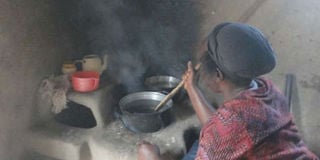Unea-6 key platform for discussing household air pollution

In-door air pollution from wood smoke. In Kenya, up to 23,000 people succumbed to household air pollution-related health issues in 2021.
As the United Nations Environmental Assembly (Unea-6) begins in Nairobi on Tuesday, delegates must engage in a serious discussion regarding the menacing household air pollution (HAP).
According to a report released by the Climate and Clean Air Coalition, HAP accounts for up to 25 per cent of black carbon emissions in Sub-Saharan Africa. And globally, the World Health Organization says over 2.4 billion people are exposed to dangerous levels of HAP.
In Kenya, up to 23,000 people succumbed to HAP-related health issues in 2021 alone, the official statistics show. The common disorders include cardiovascular and upper respiratory ones. Even as we face a widening fiscal deficit, the World Bank estimates that HAP costs the country 3.5 percent of its yearly GDP due to health consequences, productivity losses, and environmental harm. These effects are more evident in rural areas than in cities, and disproportionately affect women and girls who continue to rely heavily on traditional cooking methods.
Researchers believe there is a clear link between widespread HAP levels and the environmental impacts of climate change. These include droughts, floods, and other extreme weather events we have witnessed in recent years. Dr Benjamin Tsofa, a Senior Health Economist at Kemri, believes that black carbon, a short-lived climate pollutant produced by the combustion of solid fuels such as charcoal and firewood, may be silently causing our low agricultural output.
According to the World Bank, investment in clean cooking technology and energy-efficient solutions would create new prospects for growth and jobs through smart business ventures, as well as strengthen public health and reduce greenhouse gas emissions. That explains why the National Cookstove Program and the Kenya Climate Smart Agriculture Strategy launched countrywide campaigns to promote cleaner cooking methods.
However, they have had little substantive impact. Today, only around 30 per cent of rural households and 54 per cent of urban ones use clean cooking methods and fuels. Many more lack not only the financial resources to acquire clean energy and cook stoves but also a basic understanding of HAP and its impacts on their health.
The government should collaborate with the private sector and international partners to drive policy change that will benefit millions of Kenyans by improving air quality and setting an example for other regions in East and sub-Saharan Africa.
Key deliverables should include 1) providing urgent access to clean energy for cooking and heating, improving ventilation in homes, and promoting behaviour change to reduce exposure, 2) developing long-term solutions to improve Kenyans' health and well-being, with a special commitment to ensure that women are socially and economically empowered to transition from solid biomass cooking methods to clean cooking methods, and 3) tapping into the expertise of community health workers to reduce the burden of the disease.
These initiatives will position Kenya as a pioneer in Sub-Saharan Africa for primary and secondary prevention of HAP-related threats.
Long term, we must invest in research and innovation. According to Dr James Nyikal, a former Kemri board chair, this will be key to building solutions that are accessible, sustainable, and adapted to the greater needs and circumstances of rural Kenya.
Charles Onyango is a Global Impact Fellow at Moving Worlds Institute [email protected]





